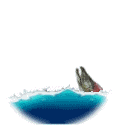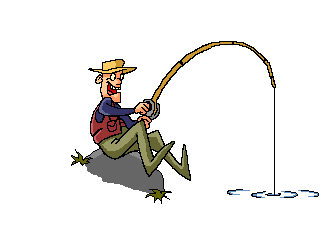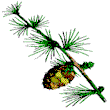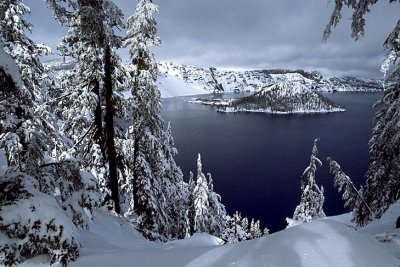





 (03/21/99)
Oregonians for Fish and Fishing
Legislative Report 8 for the week of March 15 through March 19
I'll make this short and sweet to make up for last week.
SB130 Oregon Trout has said it will support SB130, so long as there is
an appropriation to study the effects of hatchboxes, which they say have never been shown to work or not to work. What they don't seem to realizeis that we are already started looking at the issue. (See Laura Jackson-UFA research project on Brush Cr. Just put the little guys in this week, have a few more to go this coming week.) Also, they probably don't realize that one of STEP's endearing characteristics is that we aren't much of an expense to ODFW.
R&E To back up a little, R&E Board met March 13. Spent a WAD of money
(if it is approved at the F&WC level and by the legislature) on restored fishways at Alsea and Rock Creek hatcheries. Haven't been passing fish as required by state law. Also will pay for access to fishways-totaling about 1.5 million (approximately). Leaves some money in what is called the "Restoration" fund. You guys need anything "restored?" "Restored" means fixed up and improved, but done to an existing facility or structure. Get your aps in.
Board was very supportive of all projects requesting funding that would provide fishing opportunity. Funded every one of them, though they sent one off to get some more community involvement and some community match.
Got any "fishing" projects up your sleeves? We have about $1.5 Million left for the rest of the two years starting in July (assuming nothing else changes). I personally am looking for terminal fisheries, but east side needs to get with the bass ponds and steelhead spawning areas, too. They haven't been getting their fair share. Get your aps in.
Tell your friends in Eastern Oregon.
F&WC The various bills floating around the legislature having to do with the structure of the Fish and Wildlife Commission are all going to be referred to the Salmon Committee. Nice for me; won't have so many different committee meetings to go to. There was also a discussion about widening the scope of the salmon committee, I think, but I had to be elsewhere. Will try to find out about it.
Commissioner who testified on enlarging the F&WC said they were thinking in terms of sub-committees of the whole so as to reduce the amount of paperwork in the various areas and make "specialists" out of some of the commissioners. He seemed amenable to having greater number of commissioners. Also believed that Commissioners should delegate decisions on seasons, etc., to the Department. This commissioner has background in commercial fishing. Comes to legislature rather than current chair who is Susan Foster. Steelheaders testified against separating out "fish" from "game" as a bad deal for the overlapping problems.
Cindy Cindy Heller has been and continues to be sicker than all get-out. Came home from helping daughter have new baby; came down sick (as did Walter) with the flu. Has been flat on back with temperature and really sick for over three weeks. Twice to the doc. No complications, just flu. She is finally just getting to the point where she is believing that she isn't going to die and doesn't wish she would. I keep telling her, "Hang in there, baby." (Walter got better in less than a week. There's no explaining some of these things.)
When she gets her feet back under her, then watch OFF smoke. I be
needing her. We have a new motto: "We're right ON the issues."
Yours for fish and fishing.
(03/21/99)
Oregonians for Fish and Fishing
Legislative Report 8 for the week of March 15 through March 19
I'll make this short and sweet to make up for last week.
SB130 Oregon Trout has said it will support SB130, so long as there is
an appropriation to study the effects of hatchboxes, which they say have never been shown to work or not to work. What they don't seem to realizeis that we are already started looking at the issue. (See Laura Jackson-UFA research project on Brush Cr. Just put the little guys in this week, have a few more to go this coming week.) Also, they probably don't realize that one of STEP's endearing characteristics is that we aren't much of an expense to ODFW.
R&E To back up a little, R&E Board met March 13. Spent a WAD of money
(if it is approved at the F&WC level and by the legislature) on restored fishways at Alsea and Rock Creek hatcheries. Haven't been passing fish as required by state law. Also will pay for access to fishways-totaling about 1.5 million (approximately). Leaves some money in what is called the "Restoration" fund. You guys need anything "restored?" "Restored" means fixed up and improved, but done to an existing facility or structure. Get your aps in.
Board was very supportive of all projects requesting funding that would provide fishing opportunity. Funded every one of them, though they sent one off to get some more community involvement and some community match.
Got any "fishing" projects up your sleeves? We have about $1.5 Million left for the rest of the two years starting in July (assuming nothing else changes). I personally am looking for terminal fisheries, but east side needs to get with the bass ponds and steelhead spawning areas, too. They haven't been getting their fair share. Get your aps in.
Tell your friends in Eastern Oregon.
F&WC The various bills floating around the legislature having to do with the structure of the Fish and Wildlife Commission are all going to be referred to the Salmon Committee. Nice for me; won't have so many different committee meetings to go to. There was also a discussion about widening the scope of the salmon committee, I think, but I had to be elsewhere. Will try to find out about it.
Commissioner who testified on enlarging the F&WC said they were thinking in terms of sub-committees of the whole so as to reduce the amount of paperwork in the various areas and make "specialists" out of some of the commissioners. He seemed amenable to having greater number of commissioners. Also believed that Commissioners should delegate decisions on seasons, etc., to the Department. This commissioner has background in commercial fishing. Comes to legislature rather than current chair who is Susan Foster. Steelheaders testified against separating out "fish" from "game" as a bad deal for the overlapping problems.
Cindy Cindy Heller has been and continues to be sicker than all get-out. Came home from helping daughter have new baby; came down sick (as did Walter) with the flu. Has been flat on back with temperature and really sick for over three weeks. Twice to the doc. No complications, just flu. She is finally just getting to the point where she is believing that she isn't going to die and doesn't wish she would. I keep telling her, "Hang in there, baby." (Walter got better in less than a week. There's no explaining some of these things.)
When she gets her feet back under her, then watch OFF smoke. I be
needing her. We have a new motto: "We're right ON the issues."
Yours for fish and fishing.
 |




  Oregon entered the union on February 14, 1859 State bird - Western Meadowlark State Motto-She flies with her own wingsState Flower-Oregon Grape State Tree-Douglas Fir State Nick Name- Beaver State State Capitol-Salem  Oregon, one of the Pacific states of the United States. It is bordered on the north by Washington, on the east by Idaho, on the south by Nevada and California, and on the west by the Pacific Ocean. Oregon contains some of the most beautiful scenery in the United States as well as some of the nation's most fertile soils and richest timberlands. However, it was the beaver that first gave rise to the development of Oregon. Oregon's nickname, the Beaver State, harks back to the early years of the 19th century. Fur hats were fashionable at that time, in northeastern cities, and Oregon's streams were an important source of beaver. With competition fierce among the fur companies for control of the western lands, adventurous trappers, called mountain men, became the first white people to know the region well. Later, when the rage for beaver hats had passed and Oregon's beaver supply was all but exhausted, the mountain men showed the early pioneers a route they had picked out in their trapping years. Known as the Oregon Trail, it took thousands during the 1840s to the fertile Willamette Valley, where wheat, fruits, and vegetables thrived. Settlers were also drawn to other parts of the state, where a profitable timber industry later developed around Oregon's bountiful supply of Douglas fir trees. By the mid-1990s the timber industry, while still critical to Oregon's economy, was waning as access to old growth stands of trees diminished. Meanwhile, manufacturing was growing, fueled by technology industries in the Willamette Valley. The origin of the state name is uncertain. It may, however, be derived from the French ouragan, meaning storm or hurricane. The Columbia River may have been called the River of Storms by the early French Canadian trappers. 
THE OREGON TRAIL The Oregon Trail was the overland pioneer route to the northwestern United States. About 3200 km (about 2000 mi) long, the trail extended from Independence, Missouri, to the Columbia River in Oregon. Part of the route followed the Platte River for 870 km (540 mi) through what is now Nebraska to Fort Laramie in present-day Wyoming. The trail continued along the North Platte and Sweetwater rivers to South Pass in the Wind River Range of the Rocky Mountains. From there the main trail went south to Fort Bridger, Wyoming, before turning into the Bear River valley and north to Fort Hall in present-day Idaho. In Idaho the Oregon Trail followed the Snake River to the Salmon Falls and then went north past Fort Boise (now Boise). The route entered what is now Oregon, passed through the Grande Ronde River valley, crossed the Blue Mountains and followed the Umatilla River to the Columbia River. Shorter and more direct routes were developed along some parts of the trail, but they were often more difficult. Originally, like many other main routes in the United States, sections of the Oregon Trail had been used by the Native Americans and trappers. As early as 1742, part of the trail in Wyoming had been blazed by the Canadian explorer Pierre Gaultier de Varennes, sieur de La Vérendrye; the Lewis and Clark expedition, between 1804 and 1806, made more of it known. The German-American fur trader and financier John Jacob Astor, in establishing his trading posts, dispatched a party overland in 1811 to follow the trail of these explorers. Later, mountain men such as James Bridger, who founded Fort Bridger in 1843, contributed their knowledge of the trail and often acted as guides. The first emigrant wagon train, headed by the American pioneer physician Elijah White, reached Oregon in 1842. The trip took the early pioneers four to six months, a journey fraught with much hardship resulting from poor equipment, illness, and attack by the Native Americans, for whom the growing number of pioneers on the trail was an ever-constant threat. At first, the termination point of the Oregon Trail was Oregon City, Oregon; later, settlers continued south to the fertile and valuable land in the Willamette Valley.   OREGON TIME TABLE 1788 American Captain Robert Gray, the first white man to set foot in Oregon, sails into Tillamook Bay. 1792 Gray discovers and names the Columbia River. 1805 The Lewis and Clark expedition reaches the Pacific coast and explores the Columbia and Willamette river valleys. 1811 Astoria is founded by John Jacob Astor's Pacific Fur Company. 1818 The United States and Great Britain agree to joint occupancy of the Oregon country. 1825 John McLoughlin of the Hudson's Bay Company builds Fort Vancouver on the northern bank of the Columbia River. 1832 Boston merchant Nathaniel Wyeth arrives in Oregon. 1834 Jason Lee establishes a Methodist mission in the Willamette Valley. 1843 About 900 pioneers arrive in Oregon via the Oregon Trail, and a provisional government is established. 1846 The boundary between British Canada and the United States is fixed at the 49th parallel. 1848 The Oregon Territory is established by Congress. 1857 Oregon's state constitution is drawn up. 1859 Oregon is admitted to the Union as the 33rd state (February 14). 1877 The Nez Percé peoples are removed from the Wallowa Valley, and the Nez Percé War takes place. 1884 The Oregon Short Line links the state with the transcontinental railroad in Granger, Wyoming. 1902 The initiative and referendum amendment to the state constitution is adopted. 1938 The Bonneville Dam on the Columbia River begins producing power. 1990 The northern spotted owl is listed as a threatened species by the U.S. Department of Fish and Wildlife, placing new pressures on the logging industry.  |


